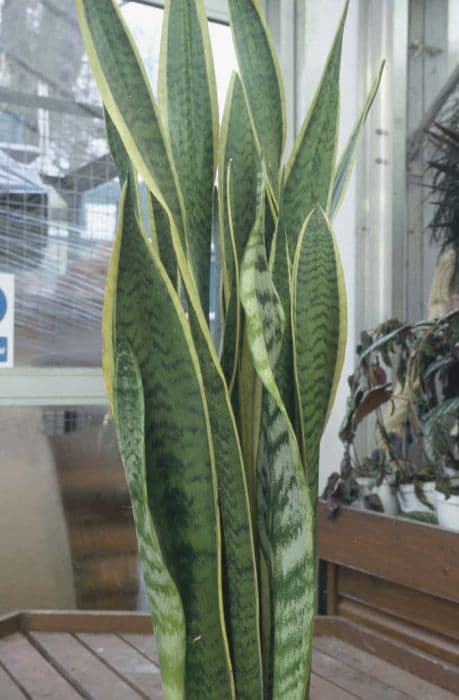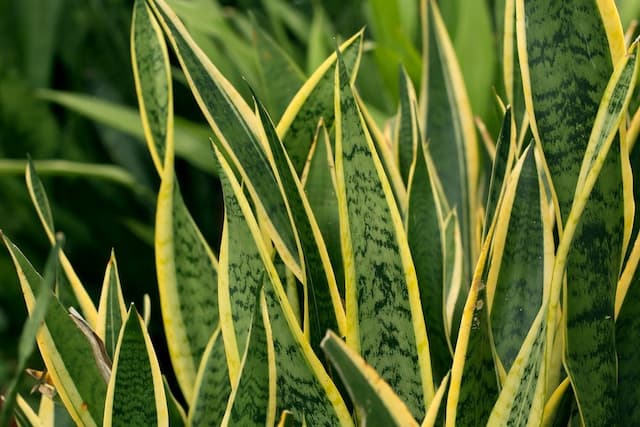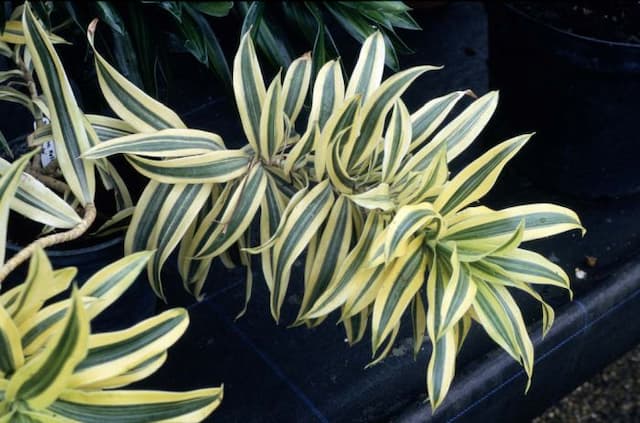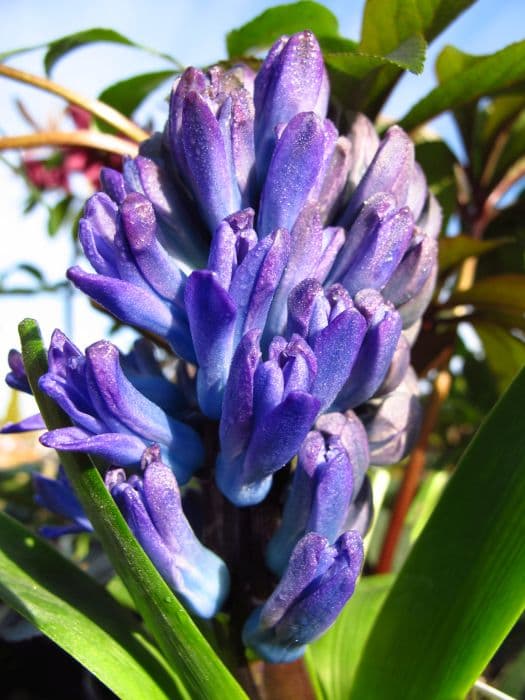Corn plant Dracaena fragrans



ABOUT
The slow-growing shrub Corn plant is usually grown as an indoor plant. The plant is called Corn plant because of the resemblance of the tall, unbranched stem to a corn stalk.
This plant grows with one or more canes (stems) and then produces new stems and a crown of leaves near the top of the cane.
The plants can grow up to 6 feet indoors, and 8,5 feet outdoors. But they can be cut off at the top once they reach a suitable height.
The most popular types of Corn plant leaves can be green along the outer edge and yellow in the center, or yellow and green striped along the edges with green in the center. The broad and glossy, lanceolate leaves arc and curve beautifully in a rosette.
The Corn plant produces fragrant flowers in its natural habitat, but it is unlikely to bloom indoors.
About this plant
 Names
NamesFamily
Asparagaceae
Synonyms
Striped dracaena, Compact dracaena, Cornstalk Dracaena, Dragon Tree, Ribbon plant, Cornstalk dracaena
Common names
Dracaena deremensis
 Toxicity
ToxicityTo humans
In fact, Corn plant can be classified as poisonous, even if slightly poisonous. It contains so-called saponins in all parts of the plant. These plant substances are harmless, but in this concentration present in Corn plant, consumption can have health consequences.
The consequences can be nausea and vomiting, to the decomposition of vital red blood cells.
But it can happen only if you ingest Corn plant in really large quantities, which is unlikely. Therefore, keep the plant out of the reach of children.To pets
According to ASPCA, Corn plant is on the list of poisonous plants for dogs, cats and horses.
All parts of the plant contain so-called saponins, which are harmful to animals.
Symptoms of poisoning in pets may include vomiting, sometimes with blood, depression, anorexia, hyper-salivation, dilated pupils (cats only).
 Characteristics
CharacteristicsLife cycle
Perennials
Foliage type
Evergreen
Color of leaves
Green
Flower color
White
Height
Up to 8 feet
Spread
Up to 1,5 feet
Plant type
Shrub
Hardiness zones
8
Native area
Sudan
Benefits
 General Benefits
General BenefitsStress reduction: Research has shown that having plants indoors can help reduce stress levels and improve mood, and Dracaena fragrans is no exception.
Increased productivity: Studies have found that having plants in the workplace can improve productivity and concentration, making Dracaena fragrans a great choice for office settings.
Aesthetic appeal: With its tall, spiky leaves and striking appearance, Dracaena fragrans can add a touch of natural beauty and visual interest to any space.
Easy to care for: Dracaena fragrans plants are relatively low-maintenance and can thrive in a variety of lighting conditions, making them a great choice for beginners or busy individuals. Medical Properties
Medical PropertiesThis species has been used for many medical purposes, including inducing labour, treating malnutrition, and fighting disease
 Air-purifying Qualities
Air-purifying QualitiesCorn plant is very effective in removing pollutants from the air.
It can reduce indoor air pollutants such as formaldehyde, benzene, trichloroethylene and carbon dioxide. Other Uses
Other UsesNatural dye: The leaves of the Dracaena fragrans plant can be boiled to create a natural green dye, which can be used to color fabric or other materials.
Food source: In some cultures, the leaves and stems of the Dracaena fragrans plant are used as a food source. The young shoots can be boiled or roasted and eaten like asparagus, while the older leaves can be used to wrap and cook meat or fish.
Medicinal properties: Some studies have found that the roots and leaves of the Dracaena fragrans plant have medicinal properties and can be used to treat a variety of ailments, such as inflammation, pain, and fever.
Insect repellent: The essential oil extracted from the leaves of the Dracaena fragrans plant has insect-repellent properties and can be used to deter pests like mosquitoes and flies.
Spiritual significance: In some cultures, Dracaena fragrans is believed to have spiritual significance and is used in rituals or ceremonies to promote healing, protection, or good luck.
Interesting Facts
 Feng Shui
Feng ShuiBecause of the plant’s ability to reach a considerable height without going overboard, it is a very suitable plant to place on corners and blades in the house to counter Sha Chi.
 Zodiac Sign Compitability
Zodiac Sign CompitabilityScorpios are often misunderstood because of their passionate, direct and overbearing nature. However, Scorpios are also ambitious, empathetic and committed to their relationships.
Dracenas are Scorpios in plant form. They will tell you exactly what they want with the change in color of their leaves, and Scorpios will love their directness. Plant Symbolism
Plant SymbolismThis plant brings good luck: it symbolizes perseverance and knowledge of one's inner world.
 Water
WaterCorn plant does not require frequent and abundant watering because it is a drought-tolerant plant.
Ideally, the plant is watered so that the top third of the substrate dries out.
In summer watering should be abundant (no more than 2 times a week).
In winter, they are reduced depending on the air temperature. Usually about once every 2 weeks. Light
LightIt is undemanding to light, but both too bright and too little light can cause the leaves to lose their color.
The eastern or western parts of the room are best.
It also requires turning to a light source so that the Corn plant does not lose its shape. Temperature
TemperatureThe most suitable air temperature is 65 - 70 °F. The plant is not afraid of heat and can survive even at 100 °F. But it is very sensitive to draughts, sharp changes.
In winter, you can arrange a dormant period for the tree by putting it in a cool place with a temperature of about 59 °F. Pruning
PruningShaping indoor Corn plant is a must in order for it to bloom and have decorative appeal. It is best to do in the beginning of spring. This is also important to stimulate the growth of lateral shoots. Pruning is done with a sharp instrument (for example, a knife), cutting off the top of the shoot, which can then be rooted. The height of the trunk is chosen according to the desired size of the plant. Usually if the trunk is bare by 1 foot, the top is cut off, leaving 4-5 leaves.
 Cleaning
CleaningOnce a week
 Soil
SoilLeaf, sod soil, compost and peat in the proportion 2:1:1:0.5.
Since Dracenae are not picky about soil, ready-made soil "For Dracenae" or "For Palms" is suitable.
The only important thing is that the acidity should be pH 6 - 6.5. Repotting
RepottingRepotting is carried out in spring, but only as needed - when the roots appear in the drainage holes. Dracaena fragrans is usually transplanted every 2-3 years, replacing only the top layer of soil.
Corn plant needs high, but not wide pots. The size is increased by 1 inch with each repotting. Humidity & Misting
Humidity & MistingIt likes high humidity. Requires frequent misting. A humidifier, wet moss, or pebbles can also increase the humidity. Corn plant also likes warm showers.
In summer the lant requires high humidity.
In winter, if the plant is at rest in a cooler room, spraying is not necessary. But if Corn plant is in a warm room, keep the humidification regimen around the dracaena. Suitable locations
Suitable locationsIndoor
All year round
Outdoor
Corn plant can be grown outdoors only in tropical climates. In temperate and continental conditions, the Dracaens is used as a compact ornamental plant.
Hardiness zone
9 - 12 USDA
 Life cycle
Life cycleCorn plant blooms very rarely in indoor conditions. If it blooms, it forms handfuls of white flowers with a strong fragrance. At this time it is not recommended to keep Dracaena in the bedroom or children's room, as the strong fragrance of the flowers can lead to dizziness and headache. The scent from the plant has some resemblance to honey mixed with the scent from freshly cut grass.
Flowering lasts about a month after which, if pollinated, orange berries will set. From these berries seeds can be collected for propagation.
After flowering and fruiting, the shoot should be cut off, leaving about 1.5 inches of it. Propogation
PropogationPropogation time
Spring, summer
By CUTTINGS:
To propagate Corn plant, cut off a portion of the stem about 8 inches long.
Place the cuttings in moist soil or water. It is best to take the cuttings when the plant is actively growing - spring or early summer. Use rooting hormone, if you have it, to speed up root development.
Keep the soil moist, or change the water at least once a week if you propagate hydroponically. You can propagate either tops, or rosettes, or stems without leaves. Rosettes have a better chance of surviving.
Keep the cuttings in bright light, but away from direct sunlight.
 Pests
PestsSpider mite, Thrips, Scale insects, Mealybug
 Diseases
DiseasesRoot Rot









